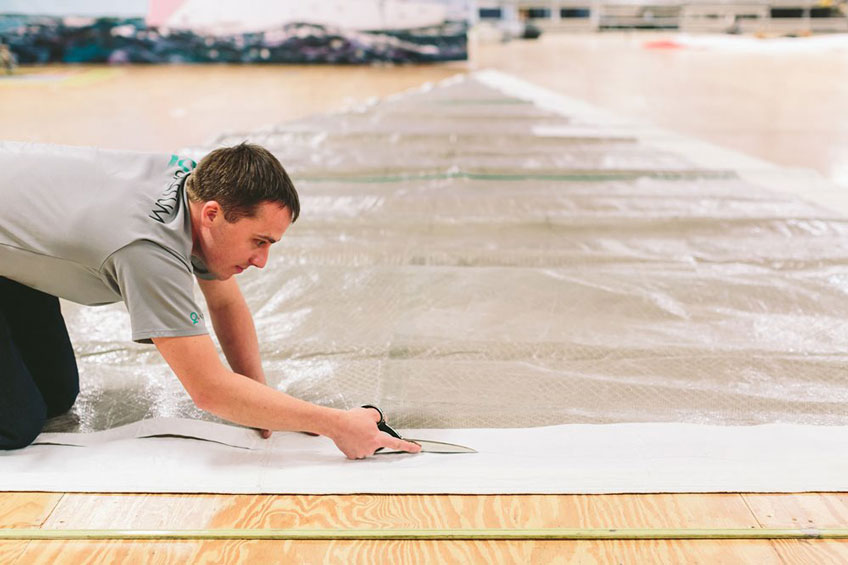Sadly, there is no such thing as a sail that lasts forever. However, when your sails become stretched out and lose their shape, it doesn’t necessarily mean you need new ones. Here's what you need to know about Precision Recuts, how they help extend the life of your sails, and save you money.

Some common symptoms of a sail that has experienced stretch and may be due for a recut include:
- Noticeable upwind pointing issues
- Visible increased round-ness of the sail draft
- Problems controlling heel
- Increased weather helm
- Difficulty with sail handling systems (furling & flaking)
- Recognizable creep in repeatable sail settings
- Changes in sailing angles and boat speed suffering
Dacron® sails, even those made with the highest quality sailcloth, are most vulnerable to stretch. Membrane sails are more stretch resistant, which improves long-term shape retention. In both cases, however, shape changes will occur over time, affecting sail performance. A Precision Recut gives new life to an older sail by restoring the sail to about 90 percent of its original shape. Both membrane and woven sails are candidates for reshaping and a recut costs significantly less than a new sail.
Recuts are hardly new to the industry; many Grand Prix teams recut their sails at the end of each racing day. That might be a bit extreme for your club racing program or your family cruiser, but getting your sail in regularly for a recut can give you tangible performance gains and make a world of difference in sail handling.
Quantum’s team of experts are trained to analyze your sail for stretch and make the best recommendations to suit your sailing needs.
Here's a look at common problems associated with older cruising and racing sails and how these problems can be addressed through Precision Recut procedures that include seam reshaping, luff curve reshape, and leech take-up.
BROAD SEAM RESHAPE
PROBLEM: Deep draft. Full sail. Can't point very high.
The sail depth becomes fuller and more rounded. The draft moves aft. You're no longer able to point as high as when the sail was new. The boat becomes harder to steer, heels more, and responsiveness is slowed. For racing boats, the inability to hold a lane or position close to other boats can really destroy a tactical game plan.
SOLUTION: Seam reshape.
Seams are reshaped and extra fabric is removed. This procedure flattens the sail and helps return the draft to the original and optimal location. Generally, three to five seams are remade to achieve desired shape.
RESULT: Faster sail. Points higher!
Your sail is now flatter, faster, and more efficient. Your boat will also sail more upright, point higher and be far more responsive.
LUFF CURVE RESHAPE
PROBLEM: Reduced entry. Sail is hard to steer.
As sails age, their entry is reduced due to a variety of factors. Stretch, as well as over-tensioning the halyard can reduce entry. Reduced entry will make the sail harder to trim, less efficient and steering more difficult (and less fun!)
SOLUTION: Luff curve change.
Luff curve can be restored to help return the sail to its original entry shape. Sometimes a luff curve change is made to remove entry and flatten the sail.
RESULT: Faster. Easier to steer sails.
Returning entry gives you a bigger range to steer inside that is still ultra-fast. Steering will be easier and you'll be able to go faster.
LEECH TAKEUP
PROBLEM: Leech falls away. Sail isn't delivering power.
On cruising Dacron® mainsails and genoas, the leech can stretch and fall away, making the sail more difficult to trim and reducing boat speed. This is especially prevalent on larger cruising mainsails and mainsails with large roaches. Leech stretch can also hamper the use of furling systems.
SOLUTION: Leech takeup.
By removing extra fabric at a seam or elsewhere on the sail, the leech can be shortened and straightened to its original dimensions and shape.
RESULT: Smooth leech with proper power and exit. More powerful sail.
By bringing the leech back to its in-line design shape, the sail is once a gain a proper foil and will deliver efficient power.
If you are experiencing any of these sail problems, contact Quantum Sails at 888-773-4889 to speak to a recut expert or contact your local loft to discuss your situation. If it sounds like a recut is a potential solution, we will perform a free sail shape analysis and provide you with the results at no charge. The analysis requires an on-the-boat photo of the flying sail, which you can do yourself quite easily.